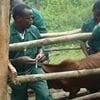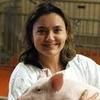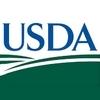Check out what is new in Pig Industry
Find the best technical articles, forums, and videos on Pig Industry at Engormix. Enter now and interact with the world's largest agricultural social network.
ABSTRACT Porcine reproductive and respiratory syndrome virus (PRRSV) and porcine parvovirus (PPV) infections cause significant economic losses to the pig industry and are considered the most economically important viral diseases of intensive swine production. Despite numerous reports on both diseases in several countries worldwide, the status of PRRSV and PPV in Nigeria remains largely unknown. Thus, a serological survey was conducted to determine the prevalence of PRRSV and PPV...
Comments : 0
Recommendations: 0
1. Introduction Deoxynivalenol (DON), commonly known as vomitoxin, is a potent mycotoxin produced by the fungus Fusarium graminearum, and its presence in wheat, corn, and barley crops can lead to them being downgraded to livestock feed grade. Pigs, and in particular young piglets, are poorly tolerant to DON contamination. Although extremely high doses of contamination in feed (20 mg/kg feed) will induce vomiting [1,2], swine will tolerate lower-level feed contamination to...
Comments : 0
Recommendations: 0


Interaction effects of feeding Bacillus subtilis DSM 32315 in weaned piglets
Suggested link
Introduction Protein is a major and expensive component of animal feed, accounting for about 20% of the total dry matter content of swine and poultry diets. Soybean meal is the leading source of feed protein [ 1 ]. In the gut, protein is hydrolyzed by endogenous proteases, principally pepsin (EC 3.4.23.1), trypsin (EC 3.4.21.4) and...
Comments : 0
Recommendations: 2
.mp4&w=3840&q=75)
Dr. Andreas Lemme, Director of Technical Consultancy, explains the challenges in poultry production today with a focus on improving sustainability, particularly finding optimum balance between the socio-ethical, environmental and economic factors. "With regards to environmental aspects, the WWF report from 2016 clearly identified the natural boundaries for coping with nitrogen and phosphorous are heavily exceeded"....
Comments : 1
Recommendations: 4
Seasonal variation in pig production has been implicated in variation in productive and reproductive performance through direct and indirect effects of temperature on physiological responses, including intestinal integrity, endocrine signaling, adipose mobilization, and insulin regulation. Heat stress in pig production results in industry losses resulting from slower growth rates, inconsistent market weights, altered carcass traits, infertility, increased health care costs and mortality. For...
Comments : 1
Recommendations: 0
INTRODUCTION For any technology to gain industry-wide adoption, it must provide value to all segments of the industry and have minimal associated risks. Immunological castration (Improvest, Zoetis Inc., Kalamazoo, MI, GnRF analog-diphtheria toxoid conjugate ) provides an effective alternative to physical castration for reducing boar odor of intact male pigs while improving lean deposition compared with physically castrated ( PC ) barrows. The effects...
Comments : 0
Recommendations: 0
Influenza A virus (IAV) is a member of the family Orthomyxoviridae possessing 8 negative sense single-stranded RNA segments and classified in subtypes based on the antigenicity of their surface glycoproteins: 18 subtypes for hemagglutinin (HA) and 11 subtypes for neuraminidase (NA). IAV can infect birds and several mammalian species, including human and swine. Pigs have an important role in the ecology of IAV, since they can become infected with both human and avian strains. Co-infection...
Comments : 0
Recommendations: 0
Introduction Soybean meal is one of the most readily available and economical protein sources commonly fed to pigs. Due to a number of anti-nutritional factors, its inclusion in newly weaned pig diets has been limited. Thus, specialty animal proteins, such as animal plasma, blood cells, or fish meal have been commonly added as highly digestible amino acid sources in starter diets. In recent years, the cost and variability of specialty animal proteins has increased while...
Comments : 0
Recommendations: 0
Introduction The U.S. swine industry is facing a significant change in production practices regarding gestation sow housing. Many pork producers across the United States are shifting from housing gestating sows in individual stalls to a group housing system. This is driven by animal welfare concerns, state legislatures, and food companies’ demands. Electronic sow feeding (ESF) is one option for feeding gestating sows within a group housing system. Electronic sow...
Comments : 0
Recommendations: 0
...
Comments : 1
Recommendations: 0
...
Comments : 0
Recommendations: 0
Introduction Oligosaccharides are a group of carbohydrate polymers containing 3 to 10 simple sugars that can be fed to pigs as prebiotics. Mannan- (Davis et al., 2002;3 Rozeboom et al., 20054 ), chito- (Liu et al., 20085 ), and fructo-oligosaccharides (Gebbink et al., 19996 ), have been shown to improve growth performance in young pigs. Possible mechanisms by which oligosaccharides benefit growth performance have been proposed and center on improving health status of the pig....
Comments : 1
Recommendations: 0


Interaction effects of feeding Bacillus subtilis DSM 32315 in weaned piglets
Suggested link
...
Comments : 4
Recommendations: 5
INTRODUCTION Serious public health and economic issues are related to foodborne pathogens. Many discussions have been raised on the impact of these micro-organisms of food safety in the last decade, among them the role of Salmonella in pork is of major interest (Henao et al ., 2010). Despite technological advances, Salmonella is still an important issue to the pork industry worldwide. Out of the estimated 80.3 million cases of foodborne...
Comments : 0
Recommendations: 0
Introduction In the early twentieth century, Ivanow reported the use of the artificial insemination technique (AI) in pig(1,2). However, the commercial application of AI began at the 1980s(3). Its success can be attributed to improvement in the boar:sow ratio, increase of the impact of individual boars in both genetic progress and reproductive efficiency; and limited spread of venereal diseases. Improvement in animal management and quality controls of semen doses and their...
Comments : 0
Recommendations: 0
INTRODUCTION Mycotoxins are considered important contaminants of maize-based products (Abdallah et al. 2015). The natural occurrence of aflatoxins, fumonisins, zearalenone, ochratoxin A, trichothecenes, patulin and penicillic acid is often observed in animal feed, and include the concomitant occurrence of two or more mycotoxins. These natural contaminants of cereals are found worldwide mainly in corn and its derived products. Pigs are highly susceptible to...
Comments : 0
Recommendations: 0
1. Introduction Animal products and by-products are the only natural source of vitamin B 12 (B 12 ) in human diets. Considering that B 12 is synthesized exclusively by bacteria and archaebacteria (when cobalt is not limiting), ruminant animals (e.g., cows) obtain the vitamin from synthesis by their ruminal microflora. The vitamin is further absorbed and stored in their body, which explain why the tissues and milk of these animals are especially...
Comments : 0
Recommendations: 0
















.mp4&w=3840&q=75)
.mp4&w=3840&q=75)











